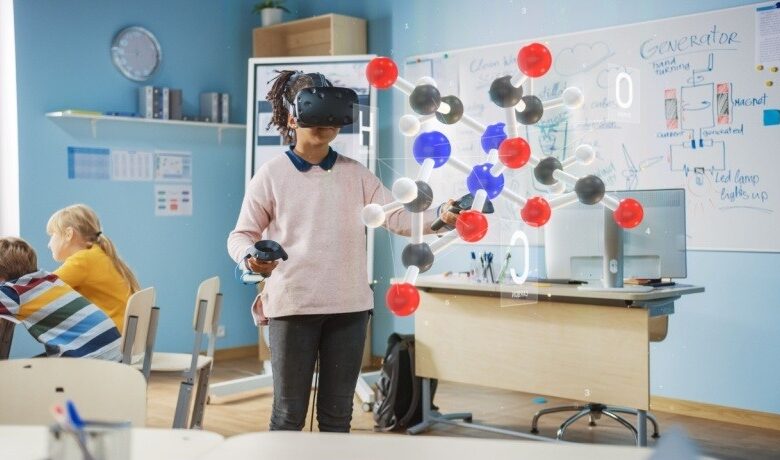Augmented Reality In The Classroom


Unlocking Learning Potential Through AR
Augmented Reality (AR) can revolutionize the classroom experience by making learning more engaging, interactive, and immersive. There are several ways educators can integrate AR into their teaching practices.
Augmented Reality In The Classroom: Uses And Benefits
1. Virtual Field Trips
AR enables students to go on virtual field trips to places they might not otherwise have access to. For example, students can explore ancient ruins, dive into the depths of the ocean, or even journey through space, all from the comfort of their classroom. This immersive experience helps students visualize concepts and fosters a deeper understanding of the subject matter. With AR, students can virtually visit historical sites, museums, or geographical locations without leaving the classroom. AR apps can overlay relevant information, 3D models, or animations onto real-world environments, providing an immersive learning experience.
2. Interactive Learning Materials
AR allows students to interact with digital content in real time, turning passive learning experiences into active ones. For instance, students can manipulate virtual objects, conduct virtual experiments, or solve puzzles using AR apps, which promotes hands-on learning and critical thinking skills. Textbooks and worksheets can be enhanced with AR content, such as 3D models, videos, or quizzes. Students can use AR-enabled devices to scan pages and access additional information or interactive activities related to the topic.
3. Science Simulations
AR simulations allow students to conduct virtual science experiments or explore complex scientific concepts in a safe and interactive environment. For example, students can dissect virtual organisms, explore the human body, or observe the solar system in 3D.
4. Language Learning
Augmented Reality in classrooms can facilitate language learning by providing immersive experiences that encourage students to practice vocabulary, pronunciation, and conversation skills. For example, AR apps can overlay labels or translations onto real-world objects, making language learning more contextual and engaging.
5. Historical Reconstruction
AR can bring history to life by reconstructing historical events, monuments, or artifacts in 3D. Students can explore ancient civilizations, reenact historical battles, or interact with famous figures from the past, gaining a deeper understanding of historical context.
6. Mathematics Visualization
AR can help students visualize abstract mathematical concepts by providing interactive models, graphs, or geometric shapes overlaid onto real-world surfaces. For example, students can explore geometric principles by manipulating virtual shapes or solving math problems in a virtual environment.
7. Art And Design
AR tools allow students to create and interact with digital artworks or 3D models overlaid onto real-world surfaces. Students can explore perspective, composition, and spatial relationships, unleashing their creativity in new and innovative ways.
8. Collaborative Learning
AR promotes collaboration and teamwork by allowing students to interact with AR content together. For example, students can collaborate on solving puzzles, completing scavenger hunts, or conducting virtual experiments, fostering communication and problem-solving skills.
9. Accessibility And Inclusivity
AR can accommodate diverse learning styles and abilities by providing alternative ways to access and interact with educational content. For example, AR apps can offer audio descriptions, text-to-speech functionality, or customizable settings to meet the needs of individual learners.
10. Project-Based Learning
AR projects empower students to create their own AR experiences, fostering creativity, critical thinking, and digital literacy skills. Students can research a topic, design AR content, and present their projects to their peers, demonstrating their understanding in a meaningful and engaging way.
11. Engaging Content
Augmented Reality offers a dynamic way to present educational content. By overlaying digital information, such as 3D models, videos, or animations, onto real-world objects or environments, AR captures students’ attention and makes learning more interactive and enjoyable.
12. Collaborative Experiences
AR fosters collaboration among students by encouraging them to work together on AR-based projects or activities. For example, students can collaborate on solving AR-based puzzles, creating interactive presentations, or conducting group experiments, which promotes teamwork and communication skills.
13. Accessibility
AR can make learning more accessible to students with diverse learning needs and abilities. For example, AR apps can provide audio descriptions, text-to-speech functionality, or customizable settings to accommodate different learning styles. Additionally, AR can help bridge the gap between abstract concepts and real-world applications, making learning more tangible and relatable for all students.
14. Creativity And Innovation
AR empowers students to become creators of content rather than just consumers. By designing their own AR experiences or projects, students can unleash their creativity, experiment with new ideas, and develop valuable digital literacy and problem-solving skills. This hands-on approach to learning encourages innovation and prepares students for the rapidly evolving digital world.
By integrating AR into the classroom, educators can create dynamic learning environments that inspire curiosity, deepen understanding, and prepare students for success in the digital age.
Source link



